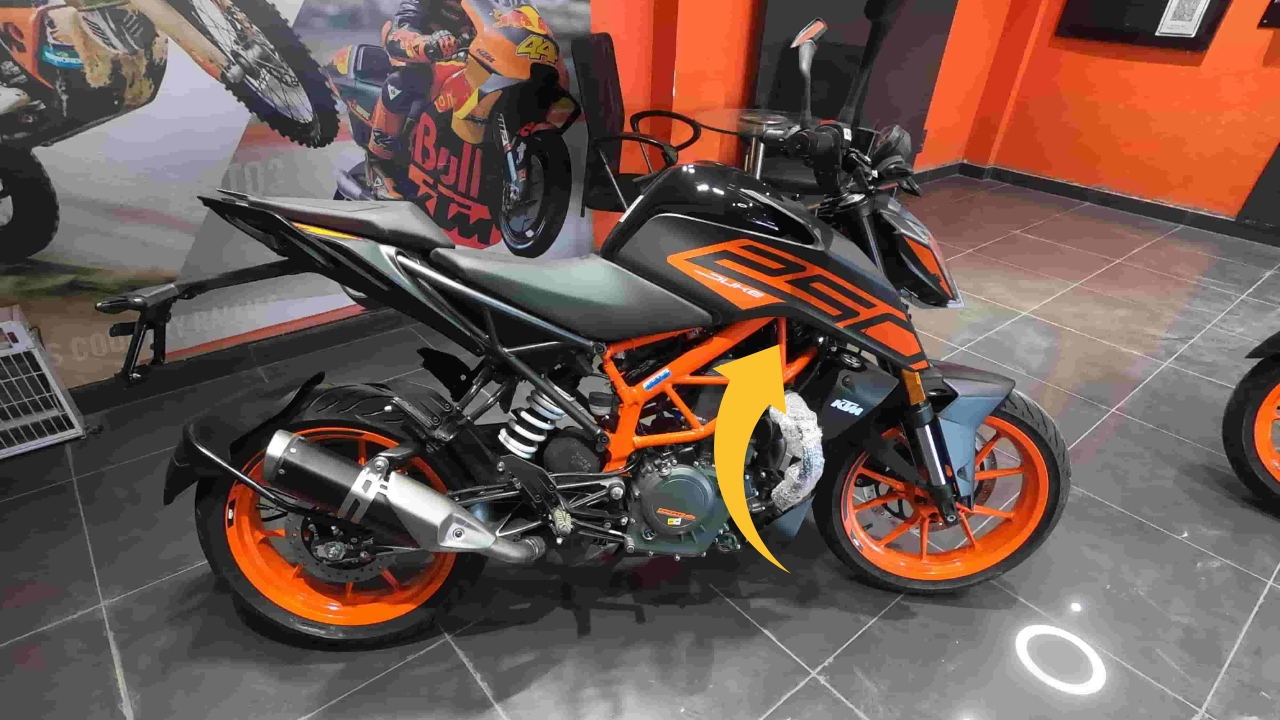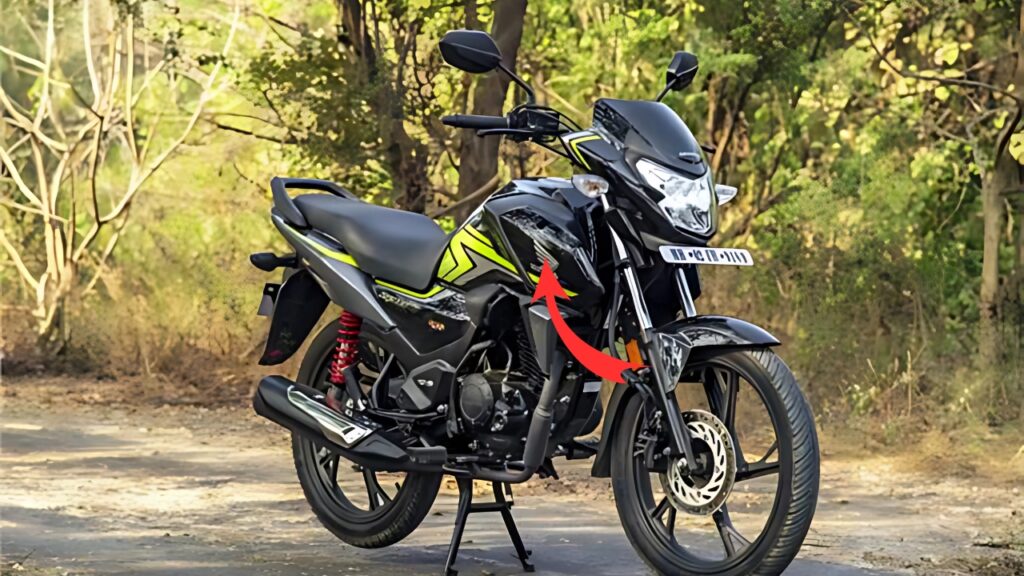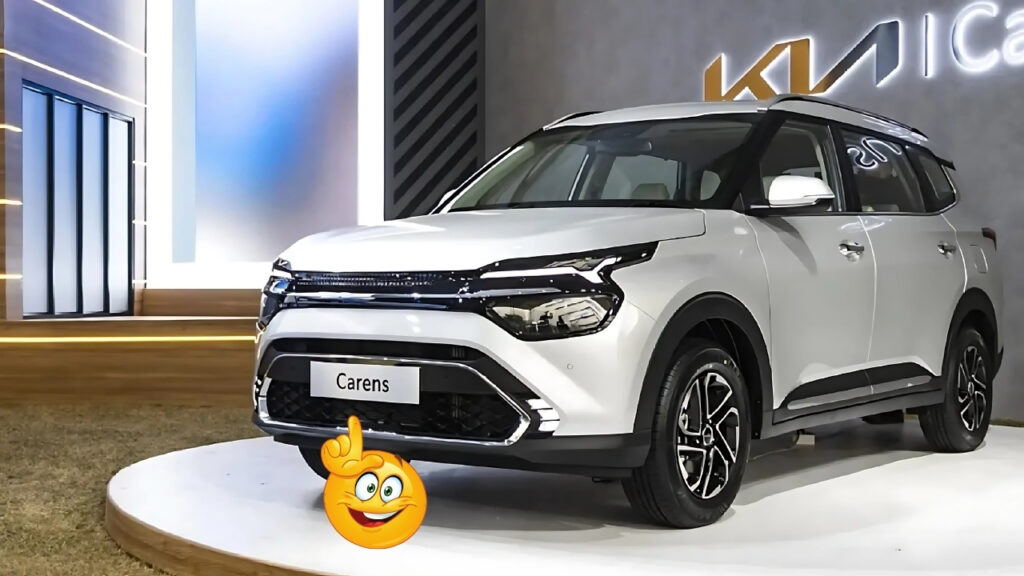KTM Duke 250: The Duke 250’s visual identity follows KTM’s distinctive design language, characterized by sharp angles, exposed mechanical components, and a minimalist approach that emphasizes function over unnecessary adornment.
The latest iteration features the split LED headlight assembly that has become a hallmark of the current Duke family, creating an unmistakable front signature that appears both futuristic and predatory.
The fuel tank extends forward with pronounced knee recesses, optimized for both ergonomics and visual impact.
Its angular shape and extended shrouds create a muscular presence that belies the motorcycle’s compact dimensions, while also housing the airbox efficiently.
The exposed trellis frame, painted in KTM’s signature orange, serves both structural and aesthetic purposes, highlighting the motorcycle’s mechanical nature while contributing to its distinctive appearance.
The tail section maintains the sharp, upswept design language with minimal bodywork, exposing the subframe and emphasizing the motorcycle’s lightweight, agile character.
The LED taillight integrates cleanly into the minimal rear cowl, while the license plate holder extends from the swingarm rather than the tail section, creating a cleaner appearance when viewed from behind.
Color schemes typically feature KTM’s recognizable orange and black combinations, though recent model years have introduced more subdued options for riders preferring a less flamboyant aesthetic.
Regardless of color choice, the Duke 250 projects an unmistakable presence that commands attention and communicates its performance intentions before the engine even starts.
Table of Contents
KTM Duke 250: Ergonomics and Rider Interface

The riding position of the Duke 250 reflects its street fighter classification, with a relatively upright handlebar position, moderately rear-set footpegs, and a seat height of approximately 810mm.
This configuration strikes a balance between aggressive control during spirited riding and reasonable comfort for daily commuting or longer journeys.
The narrow waist of the fuel tank and frame allows most riders to place their feet securely at stops despite the relatively tall seat height.
The control layout follows modern standards with easily accessible switchgear and a clean, intuitive arrangement.
The LCD instrument panel provides comprehensive information including speed, engine RPM, fuel level, gear position, clock, and various trip functions.
Recent models have transitioned to a TFT display in some markets, offering improved visibility and additional functionality including smartphone connectivity options.
The wide handlebar provides excellent leverage for quick direction changes, while the carefully considered seat profile allows riders to shift position easily during different riding scenarios.
Passenger accommodations, while present, are clearly secondary to the rider’s experience, reflecting the motorcycle’s primary focus on individual riding enjoyment rather than two-up touring.
Heart of the Machine: The Engine
The centerpiece of the Duke 250 is its liquid-cooled, single-cylinder, DOHC engine displacing 248.8cc.
This powerplant represents KTM’s extensive racing experience distilled into a street-legal package, featuring technology that was previously reserved for larger displacement models.
The four-valve head design optimizes combustion efficiency, while the dual overhead camshaft arrangement allows for precise valve control throughout the rev range.
The result is an impressively high-revving engine for a single-cylinder, with a rev limit approaching 10,000 RPM and a correspondingly exciting power delivery.
Maximum output stands at approximately 30 horsepower (22kW) and 24 Nm of torque – figures that position it advantageously against similarly sized competitors.
Fuel delivery is handled by Bosch electronic fuel injection with a 38mm throttle body, providing precise fueling across varying conditions and altitudes.
The transmission is a six-speed unit with well-spaced ratios, complemented by a mechanically actuated slipper clutch that reduces rear wheel chatter during aggressive downshifts while also lightening clutch lever effort.
Perhaps most distinctive about the Duke 250’s engine is its character. Unlike many competitors that prioritize mid-range torque for urban rideability, the KTM embraces a more rev-happy nature that rewards an engaged riding style.
Power builds progressively through the rev range, with a noticeable surge in the upper third that encourages riders to explore the tachometer’s upper reaches.
This characteristic creates a more involving, engaging riding experience that distinguishes the Duke from more utilitarian alternatives.
The exhaust system, featuring an underbelly pre-silencer and side-mounted final canister, produces a distinctive note that enhances the riding experience.
The sound is appropriately aggressive without becoming intrusive, balancing regulatory compliance with emotional appeal.
Chassis and Suspension: The Precision Platform
KTM’s expertise in creating responsive, precise-handling motorcycles is evident in the Duke 250’s chassis architecture.
The steel trellis frame utilizes the engine as a stressed member, optimizing rigidity while minimizing weight.
This construction technique creates a platform that responds immediately to rider inputs while providing essential feedback about available traction.
The suspension components reflect KTM’s premium positioning, with WP Apex inverted front forks offering 142mm of travel.
Unlike many competitors that use conventional telescopic forks in this segment, the inverted design provides superior rigidity and more precise front-end feel, particularly during aggressive cornering or braking.
The rear features a WP Apex monoshock acting on a lightweight aluminum swingarm, with 150mm of travel and adjustability for preload to accommodate varying rider weights and preferences.
The braking system comprises a single 300mm front disc with a four-piston radially mounted caliper, and a 230mm rear disc with a single-piston floating caliper.
Both are produced by ByBre (a Brembo subsidiary focused on components for lighter motorcycles) and offer progressive, powerful stopping performance.
Standard dual-channel ABS provides a safety net that can be disabled for more advanced riders in certain situations.
The wheel and tire combination consists of lightweight 17-inch alloy wheels shod with 110/70 front and 150/60 rear tires, typically from premium manufacturers like Metzeler.
This setup offers an excellent balance of grip, feedback, and longevity, allowing riders to exploit the chassis’ capabilities with confidence.
Riding Experience: The Sum of Its Parts
The Duke 250’s technical specifications translate into a riding experience that epitomizes KTM’s approach to motorcycle design.
The lightweight chassis (approximately 154kg ready to ride) combined with the responsive engine creates a motorcycle that feels alive beneath the rider, responding instantly to inputs and encouraging a more interactive riding style than many competitors.
In urban environments, the Duke 250 excels with its narrow profile, light clutch, and precise throttle response making traffic navigation almost effortless.
The upright riding position provides excellent visibility, while the responsive engine allows for quick acceleration into gaps between vehicles.
The light steering and tight turning radius further enhance the motorcycle’s practicality in congested conditions.
On open roads, the Duke reveals its sporting heritage more explicitly. The chassis provides exceptional stability during high-speed cornering, with the quality suspension components maintaining composure even over imperfect surfaces.
The engine’s character comes into its element here, with the upper rev range delivering an exciting surge of acceleration that encourages enthusiastic riding.
The braking system offers impressive stopping power with good feel at the lever, allowing riders to modulate braking force precisely.
The ABS intervention is well-calibrated, activating only when genuinely needed and doing so in a progressive manner that doesn’t abruptly interfere with control.
Perhaps most notably, the Duke 250 delivers a level of rider engagement that transcends its specification sheet.
The combination of responsive controls, communicative chassis, and characterful engine creates a motorcycle that feels special regardless of speed or road conditions – a quality that distinguishes truly exceptional motorcycles from merely competent ones.
Market Positioning and Competition
The Duke 250 occupies a strategic position in both KTM’s lineup and the broader motorcycle market.
Within the KTM range, it serves as a bridge between the entry-level Duke 125/200 models and the more powerful Duke 390 and larger displacement offerings.
This positioning makes it appealing to both newer riders looking to progress beyond their first motorcycle and more experienced riders seeking a lightweight, nimble machine without the extreme performance of larger alternatives.
In the competitive landscape, the Duke 250 faces rivals like the Yamaha MT-25, Kawasaki Z250, and Honda CB250R.
The KTM generally commands a price premium over these alternatives but justifies this through superior components, more distinctive design, and a generally more engaging riding experience that emphasizes sporting character over mere transportation.
Ownership Experience and Practicalities
Ownership considerations extend beyond the immediate riding experience to practical aspects like fuel efficiency, maintenance requirements, and reliability.
The Duke 250 typically returns fuel economy in the range of 30-35 km/l (85-99 mpg) under mixed riding conditions, providing a theoretical range of approximately 300-350 km from its 13.4-liter fuel tank.
Maintenance intervals are reasonably spaced, with major services typically required every 10,000 km.
However, the sophisticated engine design and premium components can make service costs somewhat higher than more basic alternatives.
KTM’s dealer network has expanded significantly in recent years, improving accessibility to authorized service, though coverage may still be limited in some regions.
KTM Duke 250: The Essence of KTM in a Middleweight Package
The KTM Duke 250 successfully distills the essence of the Austrian manufacturer’s performance philosophy into a more accessible package without diluting the qualities that make larger KTMs so appealing.
It offers a genuinely premium motorcycling experience in the middleweight segment, with components, performance, and character that frequently exceed category expectations.
For riders seeking a motorcycle that delivers engagement and excitement regardless of speed or context, the Duke 250 presents a compelling proposition.
It demonstrates that displacement alone doesn’t determine a motorcycle’s capability to deliver satisfaction and that thoughtful engineering can create an experience that transcends specification comparisons.
In a market increasingly divided between utilitarian transportation and extreme performance, the Duke 250 occupies a sweet spot that emphasizes the fundamental joy of motorcycling – the direct connection between rider input and machine response, the sensation of controlled power, and the precision of a well-engineered chassis.
These qualities ensure its position as a standard-bearer for accessible performance in the modern motorcycle landscape.





